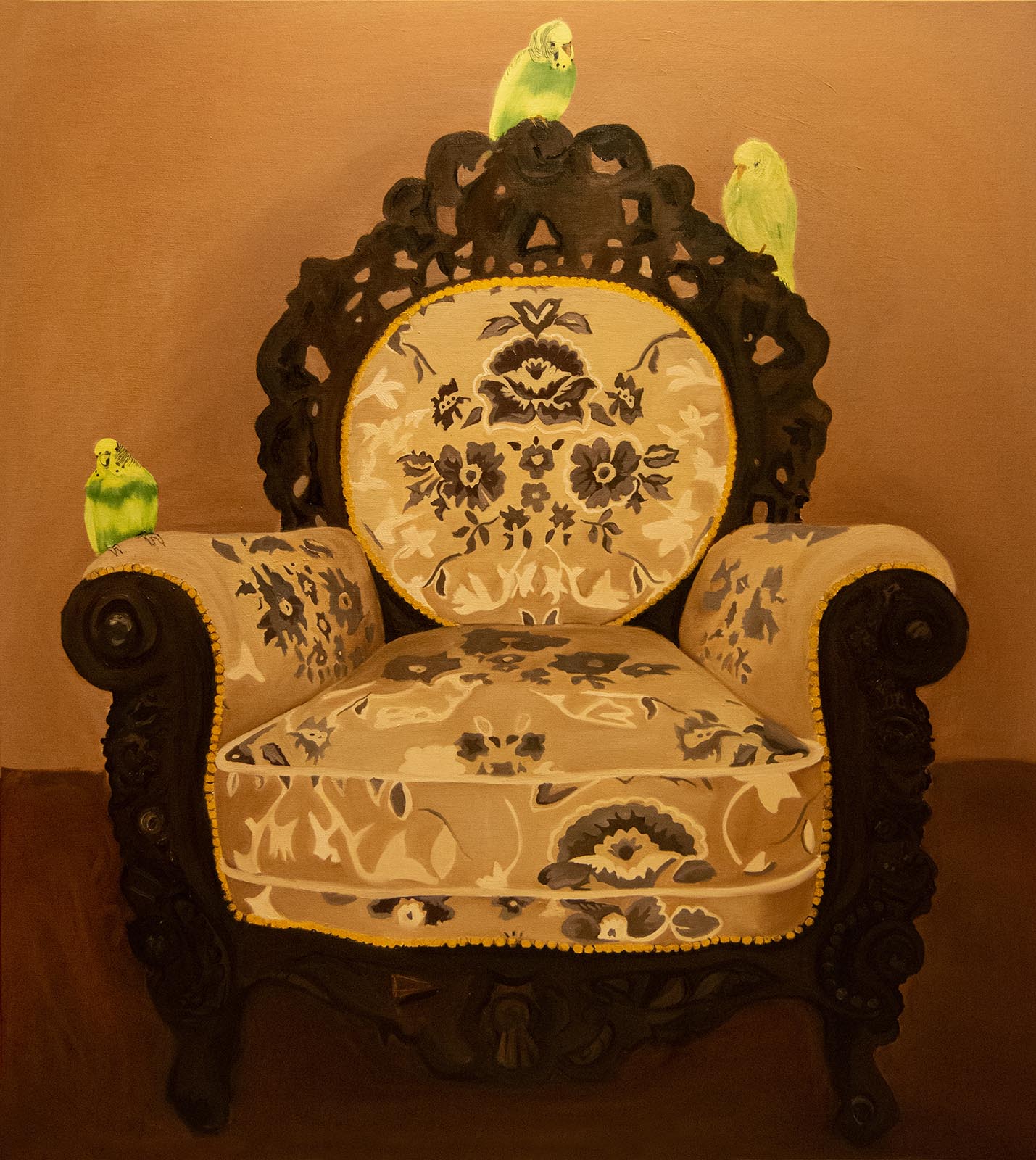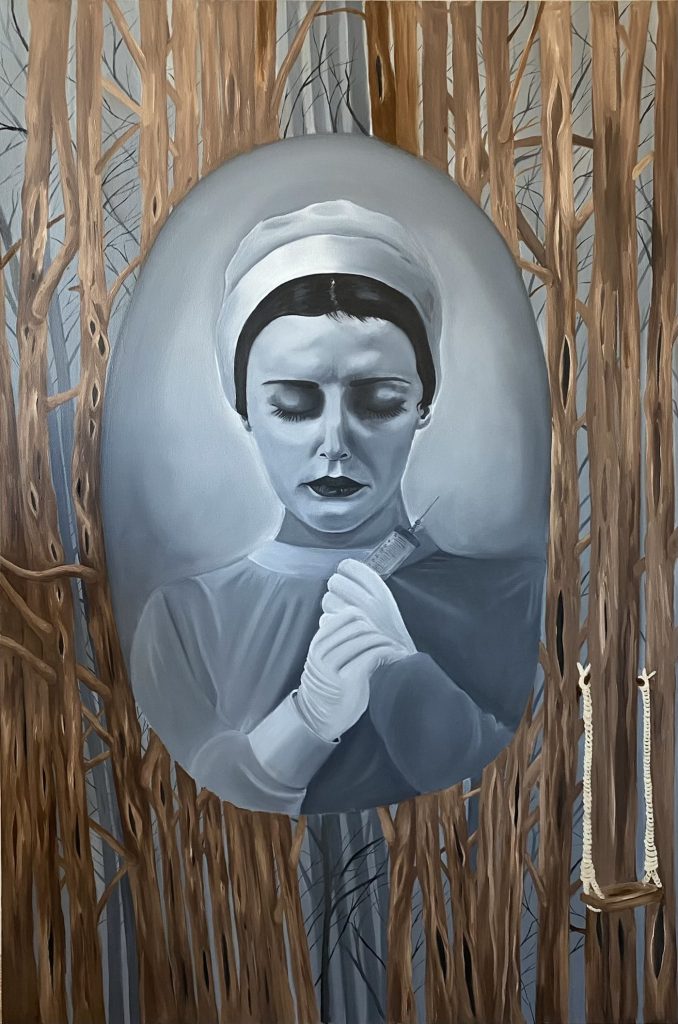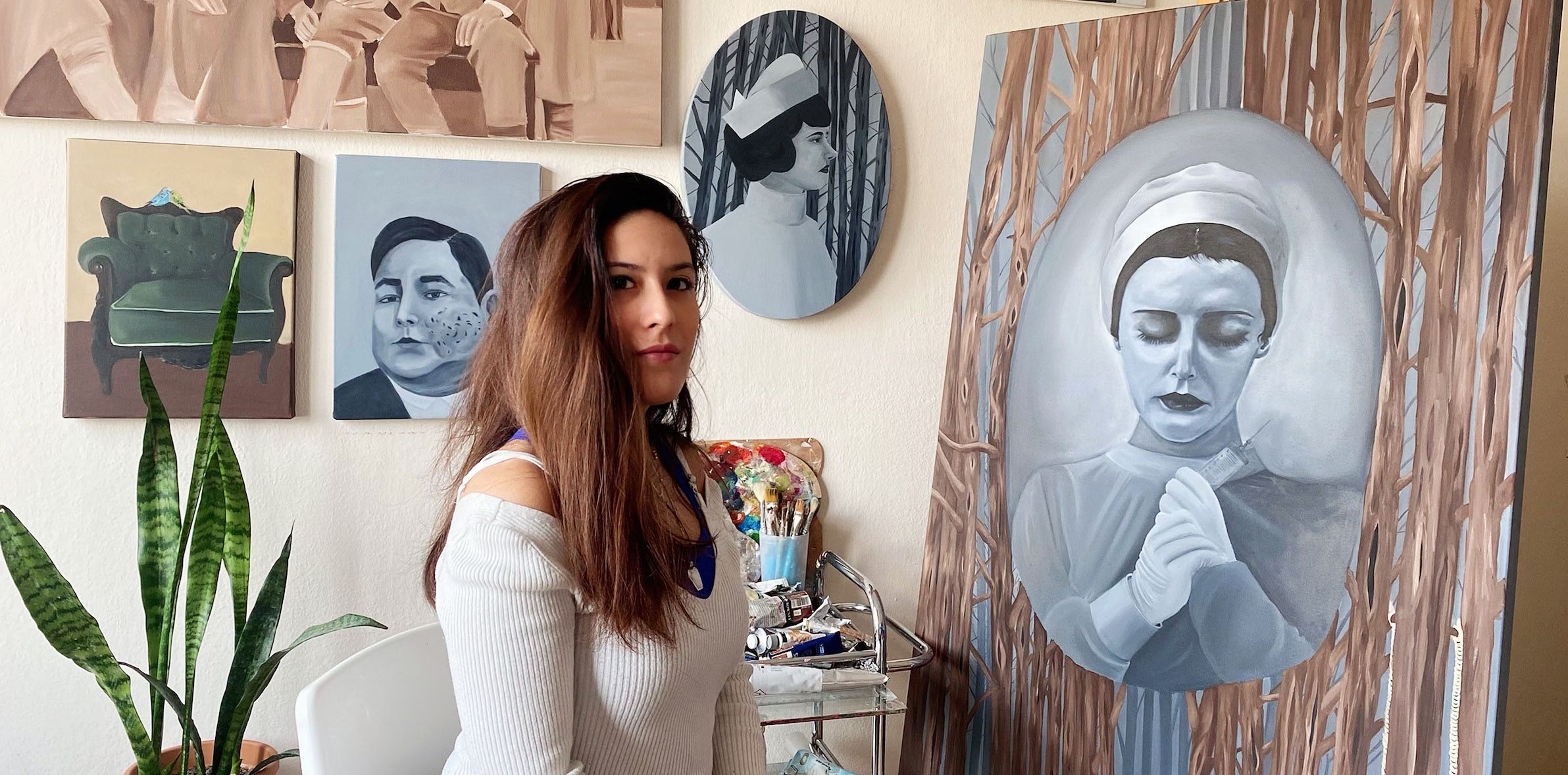In Ilsu Aslan’s paintings, it is possible to see the traces of the past and feel its scent. Throughout her artistic production process, she builds a bridge between the past and the present, based on her own life and experiences. She constructs her paintings that delve into the past and life with her own unique style. We had a conversation with İlsu Aslan about her series, the factors that triggered her production, and her future projects.
İlsu Aslan studied at Marmara University, Faculty of Fine Arts, Painting Department, and also at the Mürteza Fidan Studio. She completed her master’s degree at Yeditepe University, Faculty of Fine Arts, Department of Plastic Arts. She continues her work in Istanbul.
How did your relationship with art begin? Were you always focused on painting?
Thanks to my family, I had a childhood intertwined with every branch of art. In fact, my relationship with art was present in every phase of my life. Visiting exhibitions, going to theater plays, film and music festivals, or being involved in cultural and artistic events were among our familial routines. In this way, I was aware of every field of art, important works, and artists at a very young age. In the following years, I studied classical piano and ballet. During these times, my special interest in painting always remained in the background. After I became aware of the existence of fine arts high schools, I decided that I wanted to advance in the field of painting. During this process, my family supported me in all the decisions I made. After I graduated from the Painting Department of Ankara Anatolian Fine Arts High School, my painting education began professionally. Later, I came to Istanbul after I won the Marmara University Faculty of Fine Arts Painting Department. After graduating, I completed my master’s degree at Yeditepe University, Department of Plastic Arts.
In your works, the concepts of timelessness, absence of space, and memory come to the fore. It is possible to come across all of these concepts, especially in the ‘Let’s Have a Little Conversation’ series. How did this series come about?
Yes, my work generally progresses on these concepts. On the basis of these concepts, I sometimes look at a past moment and extract that moment from my own period of time the way I perceived it. Sometimes while doing this, I make the narration through a single image and figure. I can say that the formation process of this series was both very long and very short. The first work of the ‘Let’s Have a Little Conversation’ series was a work that I started to do for another project during my university years and left unfinished. For years it remained on the canvas surface as a half-finished project. Later, at a time when I was taking a lot of photos, I came across seats thrown into the streets. These armchairs were objects that came out of the houses and witnessed the spaces they were in for years. These armchairs, create both personal and collective memories; the fact that it represents weathered states and certain periods caused me to feel uncertain. Then I took out the work that I had left unfinished for years and completed it. The series continued like this.

There is an undeniable element of nostalgia in your compositions. What would you say about it?
The fact that the colors, images and figures I use in my works have references to past periods of life plays a big part in this attitude. It is possible for the viewer to have such connotations. I can find photographs, films, certain periods, and objects from the past interesting. I can say that this interest is purely intellectual. I have been doing research and reading about the concept of time, the relationship between photography and painting, their similarities and divergences, and their signs and ways of seeing since my university years. In my series, which I produced with reference to my old family photographs between 2013 and 2019, I looked again at the discontinuous, frozen moments in accordance with the concepts I dealt with, intervened in the signs and time of that moment, and interpreted them in other pictorial terms. There is also a contact with the past in the series ‘Let’s Have a Little Conversation’ and in my current works focusing on portraits. In my new works, on the other hand, I show the ironic expression and questioning style that I have infiltrated into the painting with vague details, with a more specific interpretation. But basically, my work progresses by questioning attitudes between certain concepts.
In your works on Art50.net, the color palette has changed in recent years and human figures have been added. How did this process develop?
I have been making figure-based paintings since 2013. In the ‘Let’s Have a Little Conversation’ series, I explained the subjects and concepts that I focused on, through chairs that have lost their reality, which serve as images, in other words, objects. In general, every series of my works are in a line that supports each other. The interrogations of my work are united in common concepts. My recent works are single-figure narratives on portraits. In ‘Tell Him I’ and ‘Tell Him II’, two of my new works on art50.net that bring a difference to my productions, we see figures with their backs turned. These figures reflect the lack of interlocutors we encounter in all areas of life that touches the problem. What they have in common with my other works is the figures with uniforms from a bygone era. As in my work named ‘Forest’ on art50.net, in my work named Hayal Meyal, which will be included in the near future, we will see a place that a figure tries to remember and the dividing point of the time period in which the figure is located. Therefore, new colors have been added to my palette along with new expressions.
What are the factors that trigger and nourish you in the artistic production process?
It actually affects many things visually, intellectually, and intellectually. I approach most disciplines with relational ties. For example, subtext, symbolic narration or a scene that I find pictorial from a movie I watch can create many new ideas for me. I have the same situation when looking at an old photo. However, I also feed off of daily life, books, archives, and culture. Therefore, it is possible to talk about many triggering data.

Who are the artists you particularly follow, admire their work, and influence you?
I can say that I have a wide range of tastes in this regard. There are names from many periods and styles that I like and find qualified. This includes contemporary art. The works that I like are generally those that have a secret language, and deep narration through images, and their indicators leave the viewer at ambiguous points. I can capture these points I have mentioned in many works belonging to different periods. If I have to list some of the artists whose works I have been very impressed with; I can say Man Ray, Rene Magritte, Hanna Höch, Gerhard Richter, David Hockney, Mama Andersson, Bill Viola. With some of his works that put the audience in the position of a witness with a conscious or unconscious approach; I can say Frans Hals, Jan de Bray, and Velazquez. The frozen moment images in Vermeer’s works also impress me.
How did you meet Art50.net? You are in one of Turkey’s leading art platforms. What are your expectations?
Like everyone else, I was aware of art50.net. The satisfaction of my artist friends with art50.net always caught my attention. So I decided to apply and after a while, I received a warm response. It is a pioneering online platform that provides the visibility of the artist and brings together the audience and the artist with a wide selection of artists. I am so glad our paths have crossed.
If you were given a huge budget and you could only buy one artist’s work with that budget, whose work would you buy?
I would definitely like to buy Rene Magritte’s “Empire of Light”. I love the works of Rene Magritte. His attitude makes me question the reality of the objects and the realistic images he paints seriously affect me. In particular, the painting I want to buy has a special place for me… Magritte states about his paintings that “a man often has a tendency to transform the stranger into the familiar with a thought game, but he tries to transform the familiar into a stranger”. We see this in his paintings as well, he carries the image beyond reality to a level of questioning.
How did the pandemic process affect your production? In this process, many online exhibitions were opened, did you have the opportunity to experience an online exhibition?
This process had staggering effects at many points around the world. The effects of the pandemic united people in a common concern, prompting everyone to self-criticize socially and individually. The economy was shaken, and unemployment rates increased even more. The balance of social life and daily routines has changed. Apart from the aforementioned shocking effects, the most important part of it was, of course, health. These anxieties affected me personally in the first place. But then I realized that this process could be a great opportunity for me to increase my productivity by concentrating on my studies. I also participated in online exhibitions and talks as much as I could. But following the exhibitions online does not satisfy me. Nowadays, cautious and limited participation is provided in exhibitions, while online exhibition systems continue.
What have you been working on lately? Do you have new projects or new ideas developing?
There’s a new series I’ve been creating recently. In this series, I move more through certain identities. Apart from this, I also want to experience new materials. They are still in the idea stage, I will have narratives and projects that will go off the canvas.
You can access İlsu Aslan’s works on Art50.net here.
Interview: Sena Arcak Bağcılar

